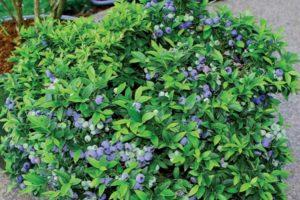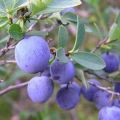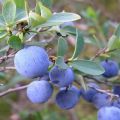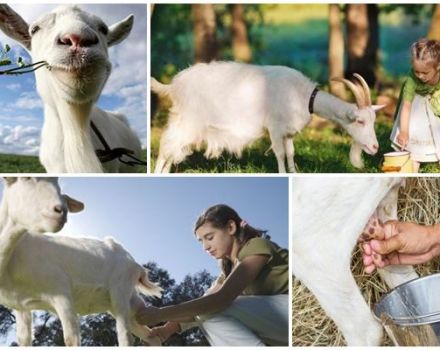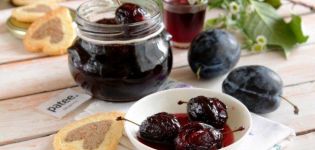Description and characteristics of the blueberry variety Spartan, planting and care rules
Blueberry Spartan is one of the favorite cultures of the inhabitants of the CIS. The juicy berry variety is easily grown in private gardens or industrial plantations. To plant a crop safely, to achieve a bountiful harvest, you should familiarize yourself with all the nuances.
Breeding history
Blueberries became popular in 1977 and were introduced in the United States. During the development of the variety, wild varieties of blueberry bushes were used, growing in the swampy areas of North America. In the countries of the former USSR, the variety has gained recognition since the late 1990s. Blueberries Spartan fell in love with gardeners because of their early maturity, rich taste of fruits and unpretentious care.
Pros and cons of blueberry Spartan
The blueberry variety has a number of positive and negative aspects. They will help you make your choice.
| pros | Minuses |
| Intense, sweet taste | Susceptibility of the bush to excessive moisture |
| Berries are easy to transport | The need for soil acidification |
| Self-fertile variety | It takes a long time to yield |
| High resistance of the bush to diseases |
Characteristics and description of blueberries
Distinctive features of the variety:
- soft bluish color;
- rounded berries;
- the average weight is 1.6 grams;
- fruit size - from 16 to 18 mm;
- the pulp is dense.
Blueberries have a pleasant taste and smell good. The tasters rated the taste of the fruit at 4.3 points.

Bush and root system
Spartan blueberry is a deciduous perennial shrub that grows up to 1.5-2 meters high. Shoots are strong, erect. The leaves are simple, elongated, dark green in color. Young foliage is bright green, turning red in September. The shrub serves as a garden decoration in autumn.
The rhizome is branched, fibrous, lies 40 cm deep. The root system grows when the earth warms up and until the end of spring. After, its growth stops, resumes after the onset of autumn. When the temperature drops, the roots stop growing. Flowers form at the ends of the branches. Buds are located along the entire length of the shoots. From each 5-10 flowers are formed.
Ripening of the harvest and fruiting of blueberries Spartan
Blueberries begin to bear fruit within 3 weeks, from mid-July. During the ripening period, the crop is harvested in 3 approaches. You can remove the berries from the bushes when they are completely colored. Fruits collected in 1-2 approaches have the best presentation, they are the largest. You can pick about 6 kilograms from one bush. The first berries are harvested at 3-4 years of culture life, a stable harvest is observed at 6-8 years. The plant blooms quite late.

How to use blueberries
Spartan blueberries can be used in a universal way; fruits are grown from it for the purpose of fresh consumption or for harvesting for the winter. Delicious vitamin teas are made from berries, they are added to baked goods. Due to its beneficial properties, blueberries are added to medicinal decoctions, mixtures and infusions are prepared. The rich taste is not lost after freezing or heat treatment. The aroma remains unforgettable, sweet and fresh.
Bush resistance to subzero temperatures and drought
The berries do not dry out, they can withstand the scorching sun, short-lived cyclones. The bush can normally exist at an air temperature of at least -30 degrees. If the frosts are long, it is better to cover it for the winter. The culture does not like drought, it can withstand only for short periods.
Disease and pest resistance
Blueberries are famous for their powerful immunity to moniliosis, the death of branches. If you do not carry out preventive treatments, there is a high risk of attack by harmful insects on the variety.
Blueberry planting algorithm
Before planting blueberries, they prepare the seedling, holes, fertilize the soil. The work must be done within a certain time frame, taking into account a suitable place. After planting, mulch the area around the bush. The variety does not imply special landing technologies, it is only important to follow the rules.
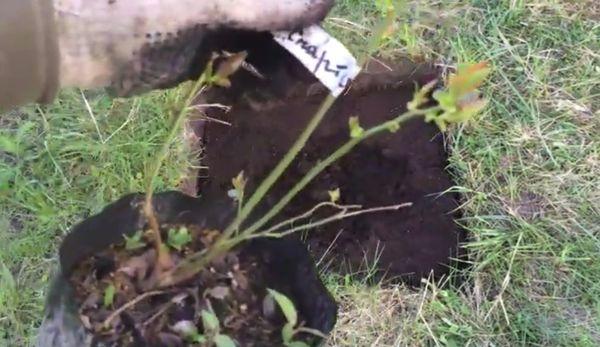
Recommended dates for planting
It is better to do planting work in March, before sap flow. Then the seedling will have time to take root by the frost. In the South, it is possible to plant a crop in the fall, if the air temperature is from 10 degrees Celsius. In the northern regions and the middle lane, it is advisable to plant the berry in the spring, since severe frosts will destroy the young seedling.
Determining the place of planting blueberries
In order to further collect 6 kg of harvest from a shrub, you need to worry about choosing the right place on the plot.
- The site should not be low, clayey, waterlogged. Constant stagnation of water at the rhizome is fraught with inhibition of their growth, deterioration of the taste of the fruit.
- The place should be well lit, blueberries love the sun's rays. Then the berries will be more delicious. It is also possible to plant a bush in partial shade, but its growth will slow down, yield will decrease, and the concentration of sugars in berries will decrease.
- Blueberries do not like to "live" in places where other cultures used to live. Bushes may die or grow poorly.
- The landing site should be well protected from drafts, especially winds in winter are dangerous.
Do not plant blueberries near trees, they will block the sun's rays.
Soil and pit preparation
Blueberries prefer to grow on humus-rich, light soils with a pH of 3.5-4.5. There should be a distance of 1.5 meters between the bushes, and 2.5-3 between the rows. For industrial purposes, a different crop cultivation scheme is practiced. The distance between shrubs is maintained at 1 meter, and 2.5 between the beds.

The hole is filled with an organic mixture consisting of 30% humus, 30% high moor peat. The rest includes rotted bedding of pine forest, pine needles, bark, river sand. The planting material is taken out of the container, the rhizome is spread. It should not be collected in a ball, bend.
The seedling is immersed in the ground 2-3 cm deeper than it grew in the container, watered. The near-stem circle is mulched with peat, rotted bark, needles.The layer creates nutrition for the mycorrhiza, the culture itself, keeps the earth from drying out loose, moist.
Cooking seedlings
When choosing a seedling, you should pay attention to 2-year-old specimens with a closed rhizome. Such a seedling is located in a pot. It is convenient to buy them, since there is no need to rush with planting work. If planting is delayed, water the seedlings with settled water.
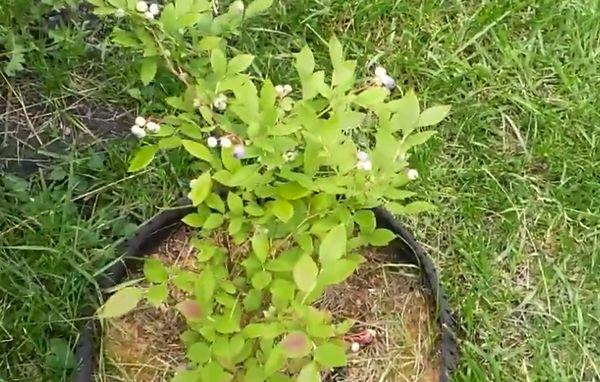
Before planting, prepare the material in this way:
- place in a clay mash for 15 minutes;
- remove the blueberries from the container, inspect the rhizome, spread with your hands.
If you ignore the last point, the roots may not break through the dense earthy clod and die.
Landing technology and scheme
Spartan blueberries should be grown according to these rules:
- dig a hole in a plot with a diameter of 60 and 50 cm deep;
- pour a drainage layer of rubble and pebbles on the bottom of the hole, put a ready-made substrate on top to form a mound;
- carefully plant a seedling on a hill, spreading the root system and covering it with earth;
Water the planting material, cover the ground with peat, straw and bark with a layer of 5 cm.
How to care for a blueberry bush
Blueberry care is easy. It consists of the following aspects:
- timely watering;
- fertilizer;
- trimming;
- weeding;
- mulching.
Shelter for the bush for the winter is also required.
Watering and feeding
Blueberries love moisture and require constant watering. Irrigation is especially important in summer, when the berries begin to ripen, flower buds are laid. If the crop lacks moisture, the crop will be poor. Water the bushes 2 times a week. 1 adult plant requires 1 bucket of water, in the morning and after sunset. In the heat, you can spray the leaves from a spray bottle, but when the sun goes down.
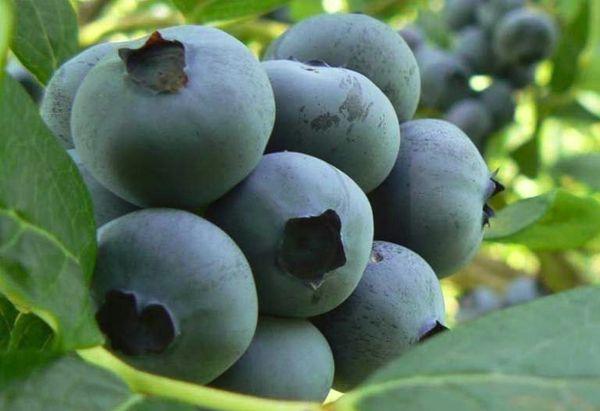
The bush easily takes root in poor areas, gives a lot of fruits. It is advisable to feed the culture with mineral fertilizing. You can buy them ready-made, complex fertilizers for conifers, heather and rhododendrons are suitable. It is advisable to feed the blueberries in the spring, before the buds swell.
With each year of the bush's life, increase the number of tablespoons by 1. Two-year-old blueberries are fertilized with 1 tbsp. feeding, 5-year old - 8, 6-year old - 16. The variety does not need fertilization with manure, humus, chicken feces.
Loosening and mulching blueberry beds
Mulching and regular loosening of the land is required for the bushes for a prosperous existence. The layer of mulch should be 2-10 cm. Spruce branches, straw, rotted leaves, sawdust are taken. After the procedure, young bushes grow slowly, as living bacteria decompose the fresh layer of mulch, pulling useful nitrogen components from the soil. This problem can be avoided by adding additional nitrogen make-up.
Loosen carefully so as not to damage the rhizome. Often it is not worth weeding the circle, this will contribute to the drying out of the bush.
Formative bush pruning
Young blueberry bushes under 4 years old require sanitary pruning. Plants over 3-4 years old can be pruned to form. The bushes have a spreading shape, the excision of the lateral branches, which are hanging, the central shoots, begin. It is important to form the maximum number of axial branches. The force of pruning affects the nature of fertility. The weaker it is, the more harvest, but the berries will be small. Otherwise, the fruits will grow large, but in smaller quantities.

During the manipulation, follow these rules.
- Weak pruning consists in excision of dead and damaged branches, old shoots that do not give new growth. Such pruning involves the removal of those branches that are near the surface of the soil.
- After 4 years of life, remove the branchy branches from the ground every year. It is necessary to leave erect shoots.
Avoid thickening the bush by removing old and damaged shoots.
Preventive treatment of blueberries
Preventive pruning involves removing the undergrowth at the bottom. Shoots older than 6 years are also excised, leaving 3 to 5 of the largest specimens. Preventive pruning stimulates growth and increases yields. The event is carried out in November or spring before the growing season.
Wintering bush
Provided that they are properly planted and caring for blueberries, they will survive the winter well. If we are talking about the Moscow region, the plant does not need shelter. In the fall, 100 g of superphosphate is introduced under it. Young seedlings are insulated with agronomic fiber and needles. A snow layer is thrown on top.
What to do with the harvest
The blueberry harvest is harvested by hand or mechanically. The berries are frozen, dried or processed into blanks. Due to its dense skin, the variety tolerates long storage well. The fruits are kept in a refrigerator.
Variety reviews
Gardeners' responses to the Spartan blueberry variety are positive. They indicate that the variety is worthy of cultivation, it is easy to care for it, the bushes do not freeze in the climatic conditions of the winters of the CIS countries.
Ekaterina Vasilievna, 57 years old, Samara
I found out about Spartan blueberries at one of the dacha forums, and decided to try it for myself. A couple of years I had to tinker, she does not like frost, requires attention and care, in other things, like everyone else. But then my worries paid off with a generous harvest. I advise everyone to get acquainted with this interesting variety.
Dima, 32 years old, Sverdlovsk region.
It so happened that I got a dacha from my parents, where, among other things, blueberries of the Spartan variety grew. I did not notice any special problems in care, the variety is responsive to fertilization, loves warmth. The harvest is good, I like the taste, in general everything is fine.

